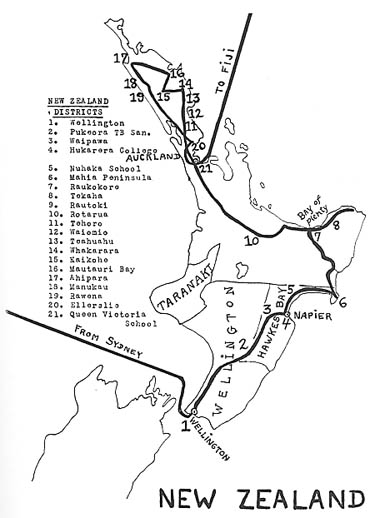
Isolated and modernized New Zealand Maori
BECAUSE of the fine reputation of the racial stock in its primitive condition, it was with particular interest that studies were made in New Zealand. Pickerill (1) has made a very extensive study of the New Zealand Maori, both by examination of the skulls and by examination of the relatively primitive living Maori. He states:
In an examination of 250 Maori skulls--all from an uncivilized age--I found carious teeth present in only two skulls or 0.76 per cent. By taking the average of Mummery's and my own investigations, the incidence of caries in the Maori is found to be 1.2 per cent in a total of 326 skulls. This is lower even than the Esquimaux, and shows the Maori to have been the most immune race to caries, for which statistics are available.
Comparing these figures with those applicable to the present time, we find that the descendants of the Britons and Anglo-Saxons are afflicted with dental caries to the extent of 86 per cent to 98 per cent; and after examining fifty Maori school children living under European conditions entirely, I found that 95 per cent of them had decayed teeth.
It will be noted that the basis of computation in the above is percentage of individuals with caries. I am using in addition to these figures the percentage of teeth attacked by dental caries. Expressed in percentage of teeth affected the figure for Pickerill's group would be 0.05 or 1 in 2,000 teeth.
We were deeply indebted to the government officials in New Zealand for their invaluable assistance. In anticipation of making these studies I had been in correspondence with the officials for over two years. When we arrived at Auckland, New Zealand, on our way to Australia, our ship was in port for one day. We were met by Colonel Saunders, Director of Oral Hygiene in the New Zealand Department of Public Health who had been sent from the capitol at Wellington to offer assistance. A personal representative of the Government was sent as guide, and transportation to the various Maori settlements in which we wished to make our studies was provided.

New Zealand is setting a standard for the world in the care of growing children as well as in many other health problems. A large percentage of the schools in New Zealand are provided with dental service. A specially trained woman was in charge of the work in each school under Colonel Saunders' supervision. The operations performed by these young women on children far exceeded in quality the average that I have seen by dentists in America. Their plan gives dental care to children twelve years of age and under, provided the parents express a wish that their children receive that care. The service was being extended rapidly to all communities. Since my return, I have learned that the work is being organized to provide for every community of New Zealand. The art of the Maori gives evidence of their great ability and skill in sculpturing. Boys and girls do beautiful carving and weaving. All native buildings and structures are embellished with carvings often in fine detail.
It was most gratifying to find neat and well-appointed dental office buildings for both natives and whites, located beside a large number of the public schools throughout New Zealand. In many communities two or three schools were served by the same operator. Children were either brought to the central dental infirmary or provision was made for an operating room in the vicinity of each school. The operator went from district to district. A typical dental infirmary is shown in Fig. 68, with Colonel Saunders and one of his efficient women operators in the foreground. I had suggested that I should be glad to have observers from the Department of Health accompany us or arrange to be present at convenient places to observe the conditions and to note my interpretations of them. From two to five such observers were generally present, including the official representative of the department. The planning of the itinerary was very greatly assisted by a Maori member of Parliament, Mr. Aparana Ngata.
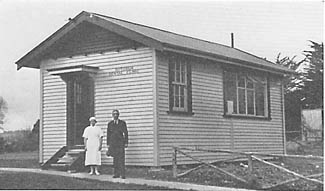
Although New Zealand is a new country with a relatively small population, there being approximately only a million and a half individuals, the building of highways has rapidly been extended to include all modernized sections. In order to reach the most remote groups it was often necessary to go beyond the zone of public improvements and follow quite primitive trails. Fortunately this was possible because it was the dry season. Even then many streams had to be forded, which would have been quite impossible at other seasons of the year. We were able to average approximately a hundred miles of travel per day for eighteen days, visiting twenty-five districts and making examinations of native Maori families and children in native schools, representing various stages of modernization. This included a few white schools and tubercular sanitariums.
Since over 95 per cent of the New Zealanders are to be found in the North Island, our investigations were limited to this island. Our itinerary started at Wellington at the south end of the North Island and progressed northward in such a way as to reach both the principal centers of native population who were modernized and those who were more isolated. This latter group, however, was a small part of the total native population. Detailed examinations including measurements and photographic records were made in twenty-two groups consisting chiefly of the older children in public schools. In the examination of 535 individuals in these twenty-two school districts their 15,332 teeth revealed that 3,420 had been attacked by dental caries or 22.3 per cent. In the most modernized groups 31 to 50 per cent had dental caries. In the most isolated group only 2 per cent of the teeth had been attacked by dental caries. The incidence of deformity of dental arches in the modernized groups ranged from 40 to 100 per cent. In many districts members of the older generations revealed 100 per cent normally formed dental arches. The children of these individuals, however, showed a much higher percentage of deformed dental arches.
These data are in striking contrast with the condition of the teeth and dental arches of the skulls of the Maori before contact with the white man and the reports of examinations by early scientists who made contact with the primitive Maori before he was modernized. These reports revealed only one tooth in 2000 teeth attacked by dental caries with practically 100 per cent normally formed dental arches.
My investigations were made in the following places in the North Island. The Pukerora Tubercular Sanatorium provided forty native Maori for studies. These were largely young men and women and being in a modern institution they were receiving the modern foods of the whites of New Zealand. Their modernization was demonstrated not only by the high incidence of dental caries but also by the fact that 90 per cent of the adults and 100 per cent of the children had abnormalities of the dental arches.
The Hukarera College for Maori girls is at Napier. These girls were largely from modernized native homes and were now living in a modern institution. Their modernization was expressed in the high percentage of dental caries and their deformed dental arches.
At the Nuhaka school an opportunity was provided through the assistance of the government officials to study the parents of many of the children. Tooth decay was wide-spread among the women and active among both the men and children.
The Mahia Peninsula provided one of the more isolated groups which showed a marked difference between the older generation and the new. These people had good access to sea foods and those still using these abundantly had much the best teeth. A group of the children who had been born and raised in this district and who had lived largely on the native foods had only 1.7 per cent of their teeth attacked by dental caries.
The other places studied were Raukokore, Tekaha, Rautoki, Rotarua, Tehoro, Waiomio, Teahuahu, Kaikohe, Whakarara, Mautauri Bay, Ahipara, Manukau, Rawena, Ellerslie, Queen Victoria School at Auckland and Waipawa.
New Zealand has become justly famous for its scenery. The South Island has been frequently termed the Southern Alps because of its snow-capped mountains and glaciers. Of the 70,000 members of the Maori race living in the two islands, about 2000 are on the South Island and the balance on the North Island. While snow is present on many of the mountains of the North Island in the winter season, only a few of the higher peaks are snow capped during the summer. Most of the shoreline of the seacoast of the South Island is very rugged, with glaciers descending almost to the sea. The coastline of the North Island is broken and in places is quite rugged. The approach to the Mahia Peninsula is along a rocky coast skirting the bay. The most important industries of New Zealand are dairy products, and sheep raising for wool.
The reputation of the Maori people for splendid physiques has placed them on a pedestal of perfection. Much of this has been lost in modernization. However, through the assistance of the government, I was able to see many excellent physical specimens. In Fig. 69 will be seen four typical Maori who retained much of the tribal excellence. Note their fine dental arches. A young Maori man who stands about six feet four inches and weighs 230 pounds was examined. The Maori men have great physical endurance and good minds. Many fine lawyers and government executives are Maori. The breakdown of these people comes when they depart from their native foods to the foods of modern civilization, foods consisting largely of white flour, sweetened goods, syrup and canned goods. The effect is similar to that experienced by other races after using foods of modern civilization. Typical illustrations of tooth decay are shown in Fig. 70. In some individuals still in their teens half of the teeth were decayed. The tooth decay among the whites of New Zealand and Australia was severe. This is illustrated in Fig. 71. Particularly striking is the similarity between the deformities of the dental arches which occur in the Maori people who were born after their parents adopted the modern foods, and those of the whites. This is well illustrated in Fig. 72 for Maori boys. In my studies among other modernized primitive racial stocks, there was a very high incidence of facial deformity, which approached one hundred per cent among individuals in tuberculosis sanatoria. This condition obtained also in New Zealand.
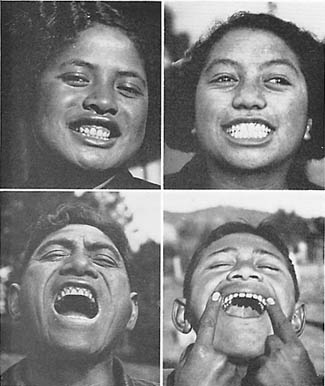

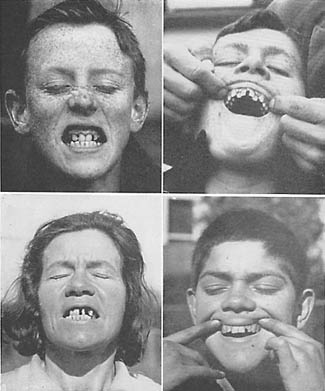

Through the kindness of the director of the Maori Museum at Auckland, I was able to examine many Maori skulls. Two views are shown in Fig. 73. The skulls belong in the pre-Columbian period. Note the splendid design of the face and dental arches and high perfection of the teeth.
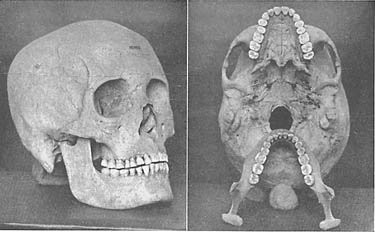
One of the most important developments to come out of these investigations of primitive races is the evidence of a rapid decline in maternal reproductive efficiency after an abandonment of the native foods and the substitution of foods of modern civilization. This is discussed in later chapters.
It was particularly instructive to observe the diligence with which some of the isolated Maori near the coast sought out certain types of food in accordance with the tradition and accumulated wisdom of their tribes. As among the various archipelagos and island dwellers of the Pacific, great emphasis was placed upon shell fish. Much effort was made to obtain these in large quantities. In Fig. 74 (lower), will be seen two boys who have been gathering sea clams found abundantly on these shores. Much of the fishing is done when the tide is out. Some groups used large quantities of the species called abalone on the West Coast of America and paua in New Zealand. In Fig. 74 (upper), a man, his wife and child are shown. The father is holding an abalone; the little girl is holding a mollusk found only in New Zealand, the toharoa; the mother is holding a plate of edible kelp which these people use abundantly, as do many sea bordering races. Maori boys enjoy a species of grubs which they seek with great eagerness and prize highly. The primitive Maori use large quantities of fern root which grows abundantly and is very nutritious.
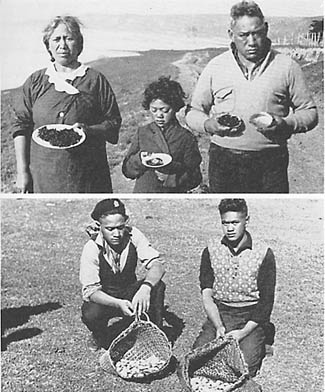
Probably few primitive races have developed calisthenics and systematic physical exercise to so high a point as the primitive Maori. On arising early in the morning, the chief of the village starts singing a song which is accompanied by a rhythmic dance. This is taken up not only by the members of his household, but by all in the adjoining households until the entire village is swaying in unison to the same tempo. This has a remarkably beneficial effect in not only developing deep breathing, but in developing the muscles of the body, particularly those of the abdomen, with the result that these people maintain excellent figures to old age.
Sir Arbuthnot Lane (2) said of this practice the following:
As to daily exercise, it is shown here that every person capable of movement can benefit by it, and I am certain that the only natural and really beneficial system of exercise is that developed through long ages by the New Zealand Maori and their race-brothers in other lands.
The practical application of their wisdom is discussed in Chapter 21.
The Maori race developed a knowledge of Nature's laws and adopted a system of living in harmony with those laws to so high a degree that they were able to build what was reported by early scientists to be the most physically perfect race living on the face of the earth. They accomplished this largely through diet and a system of social organization designed to provide a high degree of perfection in their offspring. To do this they utilized foods from the sea very liberally. The fact that they were able to maintain an immunity to dental caries so high that only one tooth in two thousand had been attacked by tooth decay (which is probably as high a degree of immunity as that of any contemporary race) is a strong argument in favor of their plan of life.
References
Next
Table of Contents
Back to the Small Farms Library